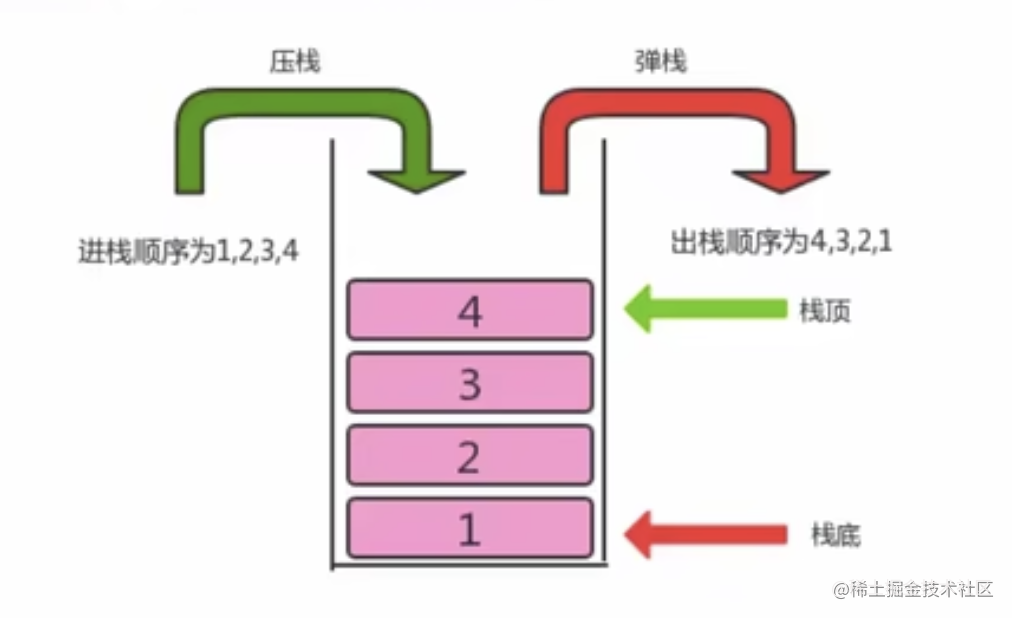前言
栈是一种基于 FILO(先进后出)的数据结构,是一种只能在一端进行插入和删除操作的特殊线性表。它按照先进后出的原则存储数据,先进入的数据被压入栈底,最后的数据在栈顶,需要读数据的时候从栈顶开始弹出数据(最后一个数据被第一个读出来)。
一、栈
我们称数据进入到栈的动作称为压栈,数据从栈中出去的动作为弹栈,如下图:

1.1、栈 API 设计
| 类名 |
Stack<T> |
| 构造方法 |
Stack() :创建 Stack 对象 |
| 成员方法 |
1、public boolean isEmpty() :判断栈是否为空
2、public int size() :获取栈中元素的个数
3、public T pop() :弹出栈顶元素
4、public void push(T t) :向栈中压入元素 t |
| 成员变量 |
1、private Node head :记录头节点
2、private int N :当前栈的元素个数 |
| 成员内部类 |
private class Node :节点类 |
1.2、栈代码实现
1
2
3
4
5
6
7
8
9
10
11
12
13
14
15
16
17
18
19
20
21
22
23
24
25
26
27
28
29
30
31
32
33
34
35
36
37
38
39
40
41
42
43
44
45
46
47
48
49
50
51
52
| public class Stack<T>{
private Node head;
private int N;
public Stack() {
head = new Node(null, null);
N = 0;
}
private class Node{
public Node next;
public T item;
public Node(Node next, T item) {
this.next = next;
this.item = item;
}
}
public boolean isEmpty(){
return N == 0;
}
public int size(){
return N;
}
public void clear(){
head.next = null;
N = 0;
}
public void push(T item){
Node temp = head.next;
Node newNode = new Node(null, item);
head.next = newNode;
newNode.next = temp;
N++;
}
public T pop(){
Node temp = head.next;
if(temp == null)return null;
head.next = temp.next;
N--;
return temp.item;
}
}
|
1.3、栈遍历
我们也让 Stack 支持增强 for 循环:
1、让 Stack 实现 Iterable 接口,重写 iterator 接口
2、在 Stack 内部提供一个内部类 SIterator,实现 Iterator 接口,重写 hasNext() 方法和 next() 方法
具体实现:
1
2
3
4
5
6
7
8
9
10
11
12
13
14
15
16
17
18
19
20
21
22
23
24
25
26
27
28
29
30
31
32
33
34
35
36
37
38
39
40
41
42
43
44
45
46
47
48
49
50
51
52
53
54
55
56
57
58
59
60
61
62
63
64
65
66
67
68
69
70
71
72
73
74
75
76
77
78
79
| public class Stack<T> implements Iterable<T>{
private Node head;
private int N;
public Stack() {
head = new Node(null, null);
N = 0;
}
private class Node{
public Node next;
public T item;
public Node(Node next, T item) {
this.next = next;
this.item = item;
}
}
public boolean isEmpty(){
return N == 0;
}
public int size(){
return N;
}
public void clear(){
head.next = null;
N = 0;
}
public void push(T item){
Node temp = head.next;
Node newNode = new Node(null, item);
head.next = newNode;
newNode.next = temp;
N++;
}
public T pop(){
Node temp = head.next;
if(temp == null)return null;
head.next = temp.next;
N--;
return temp.item;
}
@NonNull
@Override
public Iterator<T> iterator() {
return new SIterator();
}
private class SIterator implements Iterator<T>{
private Node temp;
public SIterator() {
temp = head;
}
@Override
public boolean hasNext() {
return temp.next != null;
}
@Override
public T next() {
temp = temp.next;
return temp.item;
}
}
}
|
1.4、栈测试
1
2
3
4
5
6
7
8
9
10
11
12
13
14
15
16
17
18
19
20
21
22
23
24
25
26
27
28
| public class StackTest {
public static void main(String[] args) {
Stack<String> integerStack = new Stack<>();
integerStack.push("a");
integerStack.push("b");
integerStack.push("c");
integerStack.push("d");
for (String str : integerStack) {
System.out.println(str);
}
System.out.println(integerStack.pop());
System.out.println(integerStack.pop());
integerStack.clear();
System.out.println(integerStack.size());
}
}
|
二、总结
本篇文章我们介绍了:
1、栈:一种先进后出的数据结构
2、栈的 API 设计,代码实现,增强 for 循环,测试
好了,本篇文章到这里就结束了,感谢你的阅读🤝
